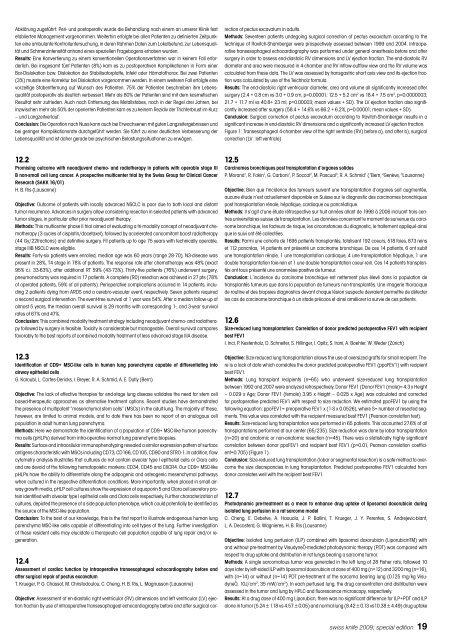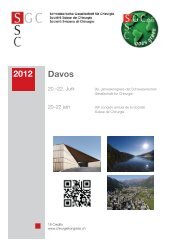Abstracts - Chirurgie Kongress
Abstracts - Chirurgie Kongress
Abstracts - Chirurgie Kongress
You also want an ePaper? Increase the reach of your titles
YUMPU automatically turns print PDFs into web optimized ePapers that Google loves.
Abklärung zugeführt. Peri- und postoperativ wurde die Behandlung nach einem an unserer Klinik fest<br />
etablierten Management vorgenommen. Weiterhin erfolgte bei allen Patienten zu definierten Zeitpunkten<br />
eine ambulante Kontrolluntersuchung, in deren Rahmen Daten zum Lokalbefund, zur Lebensqualität<br />
und Schmerzintensität anhand eines speziellen Fragebogens erhoben wurden.<br />
Results: Eine Konvertierung zu einem konventionellen Operationsverfahren war in keinem Fall erforderlich.<br />
Bei insgesamt fünf Patienten (8%) kam es zu postoperativen Komplikationen in Form einer<br />
Bar-Dislokation bzw. Dislokation der Stabilisatorplatte, Infekt oder Hämatothorax. Bei zwei Patienten<br />
(3%) musste eine Korrektur bei Dislokation vorgenommen werden. In einem weiteren Fall erfolgte eine<br />
vorzeitige Stabentfernung auf Wunsch des Patienten. 75% der Patienten beschreiben ihre Lebensqualität<br />
postoperativ als deutlich verbessert. Mehr als 80% der Patienten sind mit dem kosmetischen<br />
Resultat sehr zufrieden. Auch nach Entfernung des Metallstabes, nach in der Regel drei Jahren, bei<br />
inzwischen mehr als 50% der operierten Patienten kam es zu keinem Rezidiv der Trichterbrust im Kurz<br />
– und Langzeitverlauf.<br />
Conclusion: Die Operation nach Nuss kann auch bei Erwachsenen mit guten Langzeitergebnissen und<br />
bei geringer Komplikationsrate durchgeführt werden. Sie führt zu einer deutlichen Verbesserung der<br />
Lebensqualität und ist daher gerade bei psychischen Belastungssituationen zu erwägen.<br />
12.2<br />
Promising outcome with neoadjuvant chemo- and radiotherapy in patients with operable stage III<br />
B non-small cell lung cancer. A prospective multicenter trial by the Swiss Group for Clinical Cancer<br />
Research (SAKK 16/01)<br />
H. B. Ris (Lausanne)<br />
Objective: Outcome of patients with locally advanced NSCLC is poor due to both local and distant<br />
tumor recurrence. Advances in surgery allow considering resection in selected patients with advanced<br />
tumor stages, in particular after prior neoadjuvant therapy.<br />
Methods: This multicenter phase II trial aimed at evaluating a tri-modality concept of neoadjuvant chemotherapy<br />
(3 cycles of cisplatin/docetaxel), followed by accelerated concomitant boost radiotherapy<br />
(44 Gy/22fractions) and definitive surgery. Fit patients up to age 75 years with technically operable,<br />
stage IIIB NSCLC were eligible.<br />
Results: Forty-six patients were enrolled, median age was 60 years (range 28-70), N3-disease was<br />
present in 28%, T4 stage in 78% of patients. The response rate after chemotherapy was 48% (exact<br />
95% c.i. 33-63%), after additional RT 59% (43-73%). Thirty-five patients (76%) underwent surgery,<br />
pneumonectomy was required in 17 patients. A complete (R0) resection was achieved in 27 pts (78%<br />
of operated patients, 59% of all patients). Perioperative complications occurred in 14 patients, including<br />
2 patients dying from ARDS and a cerebro-vascular event, respectively. Seven patients required<br />
a second surgical intervention. The event-free survival at 1 year was 54%. After a median follow-up of<br />
almost 5 years, the median overall survival is 29 months with corresponding 1-, and 3-year survival<br />
rates of 67% and 47%.<br />
Conclusion: This combined modality treatment strategy including neoadjuvant chemo- and radiotherapy<br />
followed by surgery is feasible. Toxicity is considerable but manageable. Overall survival compares<br />
favorably to the best reports of combined modality treatment of less advanced stage IIIA disease.<br />
12.3<br />
Identification of CD9+ MSC-like cells in human lung parenchyma capable of differentiating into<br />
airway epithelial cells<br />
G. Karoubi, L. Cortes-Dericks, I. Breyer, R. A. Schmid, A. E. Dutly (Bern)<br />
Objective: The lack of effective therapies for end-stage lung disease validates the need for stem cell<br />
based-therapeutic approaches as alternative treatment options. Recent studies have demonstrated<br />
the presence of multipotent “mesenchymal stem cells” (MSCs) in the adult lung. The majority of these,<br />
however, are limited to animal models, and to date there has been no report of an analogous cell<br />
population in adult human lung parenchyma.<br />
Methods: Here we demonstrate the identification of a population of CD9+ MSC-like human parenchyma<br />
cells (pHLPs) derived from intra-operative normal lung parenchyma biopsies.<br />
Results: Surface and intracellular immunophenotyping revealed a similar expression pattern of surface<br />
antigens characteristic with MSCs including CD73, CD166, CD105, CD90 and STRO-1. In addition, flow<br />
cytometry analysis illustrates that cultures do not contain alveolar type I epithelial cells or Clara cells<br />
and are devoid of the following hematopoietic markers: CD34, CD45 and CXCR4. Our CD9+ MSC-like<br />
pHLPs have the ability to differentiate along the adipogenic and osteogenic mesenchymal pathways<br />
when cultured in the respective differentiation conditions. More importantly, when placed in small airway<br />
growth media, pHLP cell cultures show the expression of aquaporin 5 and Clara cell secretory protein<br />
identified with alveolar type I epithelial cells and Clara cells respectively. Further characterization of<br />
cultures, depicted the presence of a side population phenotype, which could potentially be identified as<br />
the source of the MSC-like population.<br />
Conclusion: To the best of our knowledge, this is the first report to illustrate endogenous human lung<br />
parenchyma MSC-like cells capable of differentiating into cell types of the lung. Further investigation<br />
of these resident cells may elucidate a therapeutic cell population capable of lung repair and/or regeneration.<br />
12.4<br />
Assessment of cardiac function by intraoperative transesophageal echocardiography before and<br />
after surgical repair of pectus excavatum<br />
T. Krueger, P. G. Chassot, M. Christodoulou, C. Cheng, H. B. Ris, L. Magnusson (Lausanne)<br />
Objective: Assessment of en-diastolic right ventricular (RV) dimensions and left ventricular (LV) ejection<br />
fraction by use of intraoperative transesophageal echocardiography before and after surgical cor-<br />
rection of pectus excavatum in adults.<br />
Methods: Seventeen patients undegoing surgical correction of pectus excavatum according to the<br />
technique of Ravitch-Shamberger were prospectively assessed between 1999 and 2004. Intraoperative<br />
transesophageal echocardiography was performed under general anesthesia before and after<br />
surgery in order to assess end-diastolic RV dimensions and LV ejection fraction. The end-diastolic RV<br />
diameter and area were measured in 4-chamber and RV inflow-outflow view and the RV volume was<br />
calculated from these data. The LV was assessed by transgastric short axis view and its ejection fraction<br />
was calculated by use of the Teichholz formula.<br />
Results: The end-diastolic right ventricular diameter, area and volume all significantly increased after<br />
surgery (2.4 + 0.8 cm vs 3.0 + 0.9 cm, p=0.00001; 12.5 + 5.2 cm 2 vs 18.4 + 7.5 cm 2 , p=0.0000003;<br />
21.7 + 11.7 ml vs 40.8+ 23 ml, p=0.00003; mean values + SD). The LV ejection fraction also significantly<br />
increased after surgery (58.4 + 14.6% vs 66.2 + 6.2%, p=0.00001; mean values + SD).<br />
Conclusion: Surgical correction of pectus excavatum according to Ravitch-Shamberger results in a<br />
significant increase in end-diastolic RV dimensions and a significantly increased LV ejection fraction.<br />
Figure 1: Transesophageal 4-chamber view of the right ventricle (RV) before a), and after b), surgical<br />
correction (LV : left ventricle)<br />
12.5<br />
Carcinomes bronchiques post transplantation d‘organes solides<br />
P. Morand 1 , R. Fakin 1 , G. Carboni 1 , P. Soccal 2 , M. Pascual 3 , R. A. Schmid 1 ( 1 Bern, 2 Genève, 3 Lausanne)<br />
Objective: Bien que l‘incidence des tumeurs suivant une transplantation d‘organes soit augmentée,<br />
aucune étude n‘est actuellement disponible en Suisse sur le diagnostic des carcinomes bronchiques<br />
post transplantation rénale, hépatique, cardiaque ou pancréatique.<br />
Methods: Il s‘agit d‘une étude rétrospective sur huit années allant de 1998 à 2006 incluant trois centres<br />
universitaires suisse de transplantation. Les données concernant le moment de survenue du carcinome<br />
bronchique, les facteurs de risque, les circonstances du diagnostic, le traitement appliqué ainsi<br />
que le suivi ont été collectées.<br />
Results: Parmi une cohorte de 1695 patients transplantés, totalisant 192 coeurs, 518 foies, 873 reins<br />
et 112 pancréas, 14 patients ont présenté un carcinome bronchique. De ces 14 patients, 6 ont subit<br />
une transplantation rénale, 1 une transplantation cardiaque, 4 une transplantation hépatique, 1 une<br />
double transplantation foie-rein et 1 une double transplantation coeur-rein. Ces 14 patients transplantés<br />
ont tous présenté une anamnèse positive de fumeur.<br />
Conclusion: L‘incidence du carcinome bronchique est nettement plus élevé dans la population de<br />
transplantés fumeurs que dans la population de fumeurs non-transplantés. Une imagerie thoracique<br />
de routine et des biopsies diagnostics devant chaque lésion suspecte devraient permettre de détecter<br />
les cas de carcinome bronchique à un stade précoce et ainsi améliorer la survie de ces patients.<br />
12.6<br />
Size-reduced lung transplantation: Correlation of donor predicted postoperative FEV1 with recipient<br />
best FEV1<br />
I. Inci, P. Kestenholz, D. Schneiter, S. Hillinger, I. Opitz, S. Irani, A. Boehler, W. Weder (Zürich)<br />
Objective: Size-reduced lung transplantation allows the use of oversized grafts for small recipient. There<br />
is a lack of data which correlates the donor predicted postoperative FEV1 (ppoFEV1) with recipient<br />
best FEV1.<br />
Methods: Lung transplant recipients (n=65) who underwent size-reduced lung transplantation<br />
between 1992 and 2007 were analyzed retrospectively. Donor FEV1 (Donor FEV1 (male)= 4.3 x Height<br />
– 0.029 x Age; Donor FEV1 (female) 3.95 x Height – 0.025 x Age) was calculated and corrected<br />
for postoperative predicted FEV1 with respect to size reduction. We estimated ppoFEV1 by using the<br />
following equation: ppoFEV1= preoperative FEV1 x (1-S x 0.0526), where S= number of resected segments.<br />
This value was correlated with the recipient measured best FEV1 (Pearson correlation test).<br />
Results: Size-reduced lung transplantation was performed in 65 patients. This accounted 27.6% of all<br />
transplantations performed at our center (65/235). Size reduction was done by lobar transplantation<br />
(n=20) and anatomic or non-anatomic resection (n=45). There was a statistically highly significant<br />
correlation between donor ppoFEV1 and recipient best FEV1 (p=0.01, Pearson correlation coefficient=0.705)<br />
(Figure 1).<br />
Conclusion: Size-reduced lung transplantation (lobar or segmental resection) is a safe method to overcome<br />
the size discrepancies in lung transplantation. Predicted postoperative FEV1 calculated from<br />
donor correlates well with the recipient best FEV1.<br />
12.7<br />
Photodynamic pre-treatment as a mean to enhance drug uptake of liposomal doxorubicin during<br />
isolated lung perfusion in a rat sarcoma model<br />
C. Cheng, E. Debefve, A. Haouala, J. P. Ballini, T. Krueger, J. Y. Perentes, S. Andrejevic-blant,<br />
L. A. Decosterd, G. Wagnieres, H. B. Ris (Lausanne)<br />
Objective: Isolated lung perfusion (ILP) combined with liposomal doxorubicin (LiporubicinTM) with<br />
and without pre-treatment by VisudyneÒ-mediated photodynamic therapy (PDT) was compared with<br />
respect to drug uptake and distribution in rat lungs bearing a sarcoma tumor.<br />
Methods: A single sarcomatous tumor was generated in the left lung of 28 Fisher rats, followed 10<br />
days later by left-sided ILP with liposomal doxorubicin at dose of 400 mg (n=12) and 3200 mg (n=16),<br />
with (n=14) or without (n=14) PDT pre-treatment of the sarcoma bearing lung (0.125 mg/kg VisudyneÒ,<br />
10J/cm 2 , 35 mW/cm 2 ). In each perfused lung, the drug concentration and distribution were<br />
assessed in the tumor and lung by HPLC and fluorescence microscopy, respectively.<br />
Results: At a drug dose of 400 mg Liporubicn, there was no significant difference for ILP+PDT and ILP<br />
alone in tumor (5.24 ± 1.18 vs 4.57 ± 0.05) and normal lung (8.42 ± 0.13 vs10.38 ± 4.49) drug uptake<br />
swiss knife 2009; special edition 19



